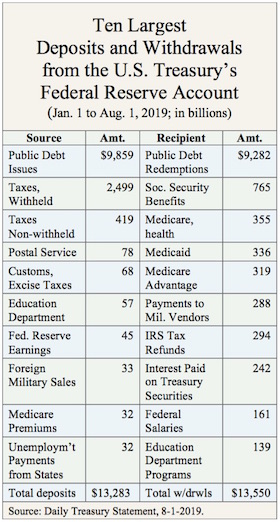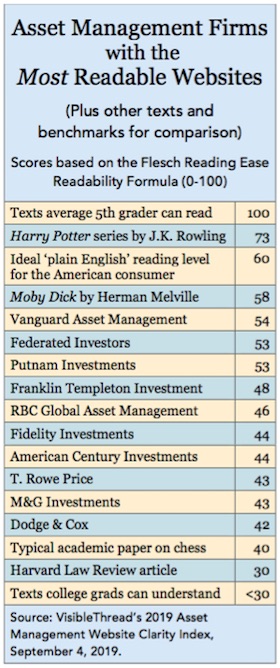
Asset Management Firms with the Most Readable Websites

IssueM Articles

Two-thirds of financial advisers holding the Retirement Income Certified Professional (RICP) designation from The American College of Financial Services say their older clients are “moderately worried that the Social Security program will drastically cut benefits in the future,” the College said in a release this week.
Among those advisers, 46% are worried about the Social Security program drastically cutting their older clients’ benefits and 54% are not.
More than 8 in 10 (84%) of RICP-holding financial advisers with older clients say cutting Social Security benefits by 20% today would “drastically alter their clients’ lifestyles.” The majority of financial advisers surveyed believe there will be a change in the Social Security program for their older clients, the College said.
“On average, 81% of advisers’ clients are taking Social Security after age 65 with only 9% of their clients taking it at the earliest age,” said Colin Slabach, the new assistant professor of retirement planning and assistant director of The American College New York Life Center for Retirement Income. “This is drastically different from the national average, with 35% of men and 40% of women claiming their benefits at the age of 62.”
Massachusetts Mutual Life Insurance Company (MassMutual) this week announced that it will enhance its field support and provide new digital tools for third party administrators (TPAs) that support 401(k)s and other defined contribution retirement plans.
The enhancements include the appointment of three TPA field support staff and the launch of a new website to provide tools and information for TPAs that work with MassMutual.
The website provides TPAs with information about MassMutual’s TPASmart program and how it supports their efforts, materials for TPAs to promote their capabilities, a fiduciary calendar for administering retirement plan regulatory requirements, and information about MassMutual’s TPA incentive program.
TPAs provide a wide range of support for retirement plans, including plan design, participant enrollment, administration and regulatory guidance. TPAs provide support for 66% of MassMutual’s retirement plans.
MassMutual’s three new appointments are:
Kathy Lake is TPA Market Director for the Southern Division. Previously, Lake was a Client Engagement Manager for MassMutual retirement plans. She has more than 20 years of experience in retirement education, sales and service center operations and has held management positions at Jackson National Life and The Hartford.
Lynette Golly is TPA Market Director for the Central Division. She joined MassMutual in 2015 after owning her own TPA firm for nearly 25 years. Most recently, Golly served as Client Engagement Manager for MassMutual, supporting retirement plans and voluntary benefits.
Rob Ayers is TPA Champion, responsible for deepening and enhancing MassMutual’s relationships with payroll providers. Ayers most recently was Managing Director of Benefits in MassMutual’s Worksite Solutions. His experience also includes TPA Market Development and Managing Director in MassMutual’s Emerging Markets and more than 10 years in various sales roles, including with Merrill Lynch.
The new additions join Kellen Craig, who is based in Arizona and covers the Western Division, and Sean Miller, based in Enfield, Conn., who covers the Northeast Division.
Only 0.9% of defined contribution (DC) plan participants stopped contributing to their accounts in the first quarter of 2019, according to the Investment Company Institute’s “Defined Contribution Plan Participants’ Activities, First Quarter 2019” report. The study tracks contributions, withdrawals, and other activity, based on DC plan recordkeeper data for more than 30 million participant accounts.
Other findings include:
ICI has been tracking DC plan participant activity through recordkeeper surveys since 2008. This update provides results from ICI’s survey of a cross-section of recordkeeping firms representing a broad range of DC plans.
© 2019 RIJ Publishing LLC. All rights reserved.
Total deferred annuity sales rose 6% in the second quarter of 2019 compared with the prior quarter, according to a preliminary version of the 88th edition of Wink’s Sales & Market Report. Highlights of the report included:
“It’s a great time to be offering annuities with growth based on an outside benchmark,” said Sheryl J. Moore, author of Wink’s Sales & Market Report, in a release. “Indexed annuity sales in the second quarter beat their previous record in 4Q2018 by nearly 3%. Sales of variable annuities and structured annuities increased nearly 20% each.”
Indexed annuities have a floor of no less than zero percent and limited excess interest that is determined by the performance of an external index, such as Standard and Poor’s 500.
Traditional fixed annuities have a fixed rate that is guaranteed for one year. MYGAs have a fixed rate that is guaranteed for more than a year.
Structured annuities have a limited negative floor and limited excess interest that is determined by the performance of an external index or sub-account. Variable annuities have no floor; their potential for gains or losses is determined by the performance of the sub-accounts. Subaccounts may be invested in an external index, stocks, bonds, commodities, or other investments.
Wink’s preliminary results are based on 94% of industry participation in Wink’s quarterly sales survey, representing 97% of the total sales.
© 2019 RIJ Publishing LLC. All rights reserved.
Fixed indexed annuity (FIA) sales were $20 billion in the second quarter of 2019, 14% higher than in the same period a year ago, according to the LIMRA Secure Retirement Institute (LIMRA SRI) Second Quarter U.S. Annuity Sales Survey.
“Despite declining interest rates, we are forecasting the current momentum of FIA sales to continue through the end of the year and expect sales of FIAs to exceed $70 billion for 2019,” said Todd Giesing, annuity research director, LIMRA SRI.
In the first six months of 2019, FIA sales were $38 billion, an increase of 18%, compared with the first six months of 2018. Fee-based FIA sales were $193 million in the second quarter. While this marks major growth for this market (188% over prior year), fee-based FIAs still represent less than 1% of the total FIA market, according to LIMRA’s release this week.
Total annuity sales were $63.9 billion in the second quarter, up 7% compared with the prior year results. This is the highest quarterly sales recorded since the first quarter 2009, and the third consecutive quarter where total annuity sales surpassed $60 billion, the survey showed. Year-to-date, total annuity sales were $124.8 billion, an increase of 11%, compared with results from the first half of 2018.
Fixed annuities represented 60% of the total annuity market in the second quarter. Fixed annuity sales have outperformed VAs sales in 12 of the last 14 quarters.
After two consecutive quarters of declines, VA sales were $25.8 billion, level with second quarter 2018 results. For the first six months of the year, VA sales were $48.6 billion, down 4%, compared with prior year results. Traditionally, VA sales are the strongest in the second quarter, the report said. LIMRA SRI expects increasing market volatility and falling interest rates to dampen VA sales for the remainder of the year. It forecasts total VA sales of under $100 billion for 2019.
Fee-based VA sales were $725 million in the second quarter. While this is down 15% from prior year, it is 10% higher than first quarter 2019 results. Fee-based VA sales represented 2.8% of the total VA market in the second quarter.
In the second quarter, registered index-linked annuity (RILA) sales were $4.14 billion, up 66% from prior year results. Year to date, RILA sales were $7.7 billion, 63% higher than results from the first half of 2018.
“While RILA sales have been driving overall VA sales growth recently – representing 16% of the total VA market – after two consecutive quarters in the $3.5 billion range, sales vaulted up,” Giesing said. “Heightened equity market volatility and the fact that major distributors have RILA products on the shelves helped RILA sales break through this plateau.”
Despite the decline in interest rates this quarter, fixed-rate deferred annuity sales rose 10% in the second quarter to $13.1 billion. In the first six months of 2019, fixed-rate deferred annuity sales totaled $28.2 billion, 35% higher than prior year results. But the impact of falling rates may simply be delayed.
“The 10-year treasury rate dropped nearly 50 basis points from the start of the second quarter,” said Giesing. “While we didn’t see significant impact on the fixed-rate deferred annuity market during the second quarter, there is usually a lag between interest-rate drops and sales declines. We anticipate sales to substantially drop in the third and fourth quarters.”
Single premium immediate annuities (SPIA) sales totaled $2.7 billion in the second quarter of 2019, up 8% from prior year. Year to date, SPIA sales were $5.5 billion, 20% higher than 2018.
“Traditionally, SPIA sales are strongly linked to interest rates. However, we see another dynamic coming into play,” Giesing said. “Over the past year, a growing portion of the assets invested in SPIAs are qualified assets. This is likely due to the rise in the number of individuals who are reaching the age for taking required minimum distributions, and choosing to convert a portion of their qualified assets into guaranteed income.”
Deferred income annuities (DIA) sales grew 26% in the second quarter, to $727 million. In the first six months of the year, DIA sales totaled $1.4 billion, 25% higher than prior year.
© RIJ Publishing LLC. All rights reserved.
There are “huge” variations in outcomes between the default funds offered by leading British defined contribution (DC) providers, according to a report in IPE.com, citing research from the UK workplace savings company Punter Southall Aspire.
The firm’s findings were based on an analysis of the growth and consolidation phases of the standard default investment options of nine leading providers in the market as at 31 March:
For the growth and consolidation phases, the funds analyzed by Punter Southall Aspire varied across many elements: design and construction, investment risk and volatility, asset allocation strategy, return benchmarks, management, “glidepaths” towards retirement, and performance.
Christos Bakas, DC investment consultant at Punter Southall Aspire, said: “We urge employers to monitor the performance of their pension funds more closely, as default doesn’t mean standard, and not all funds are created equally.”
In the growth phase, allocations to equities, bonds and other asset classes varied “dramatically” between the default funds, depending mainly on the targeted risk levels and the range of investment tools used, the survey showed.
Over the last three years, the Zurich Passive MultiAsset fund performed best (11.3%), although with higher volatility risk (8.4%) than the other defaults. The Standard Life default fund performed worst (5.4%), but with volatility (5.2%) than the other funds analysed.
Punter Southall Aspire also found that providers with their own asset management arm – Royal London, Standard Life, Fidelity, Aviva, Legal & General – tended to develop more diversified and sophisticated default offerings. But diversity and sophistication also brought higher costs.
With respect to equity allocations, the initial allocations, the changes to allocation and the at-retirement allocation are different for almost every default strategy and depend mainly on the risk levels being targeted and the range of investment tools used,” said Punter Southall Aspire, noting that Legal & General did not implement a risk-reducing strategy as members approach retirement and “would argue that it’s difficult to predict when members will retire and in fact many members don’t know when they will retire.”
© 2019 RIJ Publishing LLC. All rights reserved.
XY Planning Network (XYPN), the registered investment advisor (RIA) and third-party asset management platform (TAMP) whose advisers offer financial planning services to Gen X and Gen Y investors for a monthly subscription fee, announced its 1,000th advisor-member this week.
Luis Rosa, who was recently featured on the cover of InvestmentNews’ 2019 “40 Under 40,” is the founder of Build a Better Financial Future. Rosa immigrated to the US from the Dominican Republic in 1991, joined the financial services industry in 2001, and recently opened his own fee-only planning practice.
The 1,000 members in the Network, whose median age is 39, comprise more than 5% of all state-registered RIAs delivering financial planning services across the country. XYPN claims that its new advisor lapse rate is less than 6% in the first year (and decreases further in subsequent years as their businesses grow), compared with an industry-wide attrition rate of 70% over the first three years.
“Our turnkey financial planning platform now provides more than 1,000 advisors the support they need to start, run, and grow their own advisory firms, from the technology tools to the compliance support needed to do real financial planning for their clients, with a real community of fellow fiduciary financial planners, while allowing them to maintain real independence…with a focus that allows us to charge a fraction of what broker-dealers cost to provide similar services,” said Michael Kitces, co-founder of XY Planning Network, in the release.
© RIJ Publishing LLC. All rights reserved.

The number of life insurers offering a variable or “structured” index annuity with a lifetime income benefit has suddenly doubled. CUNA Mutual Group’s new Zone Income Annuity has joined Allianz Life’s Index Advantage Income contract, raising the number of products in this micro-niche to two.
Investors and advisers who like the risk-reward proposition of the structured index annuity (aka registered index-linked annuities or RILAs) and wish they could pair it with an income rider have had only the one option until now. Other companies have avoided attaching income riders to structured annuities, in part because they’re still digesting the living benefit risk they took on a decade ago when selling more than a trillion dollars worth of variable annuities with generous guaranteed lifetime withdrawal benefits (GLWBs).
A structured index annuity works like a fixed index annuity, except that the upper limits (caps) on returns are higher because the client agrees to accept some risk of loss. The new CUNA Mutual annuity appears to differ from Allianz Life’s Index Advantage Income in allowing the client to take extra risk (and get more upside potential) even after income begins.
Zone Income offers a 10% floor on losses, as opposed to the more common 10% buffer in this type of product. A buffer shields the contract owner from the first 10% of losses in a contract year. A floor shields the contract owner from a loss in excess of 10% in a year. Zone Income has only one term length—six years—and a starting surrender penalty of 9%.
Contract owners can get exposure to the S&P500 Index of large-cap domestic stocks, the MSCI-EAFE Index of developed country stocks, or the Russell 2000 Index of small-cap domestic stocks, or they can invest in a fixed rate account. Here are the current rates (to August 25, 2019):
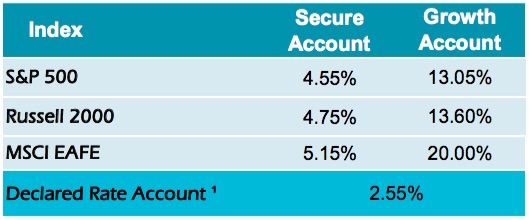
The money that’s dedicated to each index option then has to be split between a Secure Account and a Growth account, in 0% to 100% deciles. Each combination has its own upside cap and its own downside floor. For the S&P500, a 50/50 Secure/Growth split would have a cap of 8.8% and a floor of -5%.
“Our belief is that people like a known risk rather than an unknown risk,” said Martin Powell, CUNA Mutual Group’s head of annuity distribution. “So we allow the client to dial the risk up or down. They can take a -2.5% floor one year and move to zero the next year. It also helps advisers with their compliance requirements.”
As for Zone Income’s lifetime income rider, the client invests a lump sum at a certain age, and is assigned a certain base withdrawal rate (such as 4.5% for a single person age 60 to 64). The starting benefit base (the amount by which the withdrawal rate will be multiplied to determine the annual payout) is the purchase premium. For every year the client delays taking income, the withdrawal rate goes up by 0.30 percentage points. Unlike a deferral bonus that increases the benefit base—a characteristic of benefit riders of a decade or more ago—a withdrawal-rate bonus doesn’t raise contract fees. The benefit base can increase over time as the account value grows, but it cannot go down.
For instance, a couple that bought the Zone Income Annuity when both were age 60 would have a starting withdrawal rate of 4%. If they waited five years to take their first withdrawal, their lifetime withdrawal rate would have risen by 30-basis points per year to 5.50%. (A single person’s withdrawal rate would be 0.50% higher.) There’s an annual 0.75% contract fee and a 0.50% income rider fee.
“We give you both the step-up in account value each year [if there’s a gain], and the 30-basis point increase in the withdrawal rate,” said Elle Switzer, director, annuity product development at CUNA Mutual Group. Her company has the risk budget to attach a living benefit to its RILA because it doesn’t have a big book of living benefit business, and the risks associated with one, left over from historical VA sales.
Allianz Life’s Index Advantage Income contract, which launched in August 2018, works a bit differently. The minimum benefit base is not locked in until income payments start, rather than at the purchase date as in the Zone Income product. At 5.20%, Index Advantage Income’s base withdrawal rate for a couple at age 60 is much higher than Zone Income’s. With deferral credits of 1.8 percentage points, the withdrawal rate rises to 7.0% after a five-year wait.
There’s a trade-off, however. After income starts, all of the money in Index Advantage Income moves into the equivalent of a fixed indexed annuity contract and stays there. The Zone Income contract owner, by contrast, can continue to enjoy much higher caps than the Index Advantage owner during the payout phase, and potentially achieve a higher annual income. Index Advantage has a 1.25% annual contract fee and a 0.70% income rider fee. It has a single six-year term and the surrender penalty starts at 8.5%.
© 2019 RIJ Publishing LLC. All rights reserved.
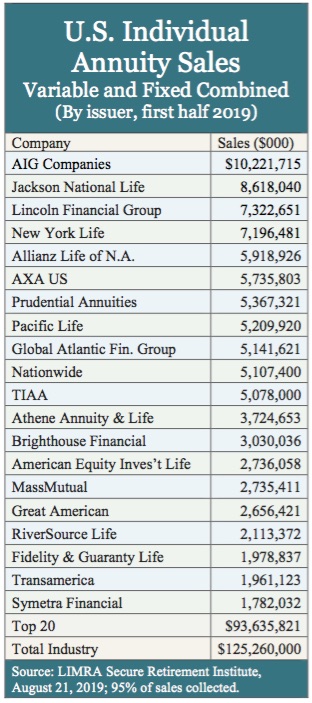
The sea change in the business models of top advisors toward holistic advice and asset-based fees has been substantiated by a recent survey of the members of the Investments & Wealth Institute (formerly IMCA). The institute and Cerulli Associates conducted the survey.
Ten years ago, fewer than one in five Institute advisors operated in one of the independent advisory channels, the survey showed. Today, 45% of Institute advisor members are independent, either working in an independent RIA firm (23%), in an independent broker/dealer firm (9%), or in a dually-registered or hybrid firm (13%).
IWI members are nearly twice as likely to report operating in a primarily fee-based practice relative to the industry average (62% vs. 38%, respectively). By 2020, members expect brokerage assets to make up just 10% of their client assets.
The survey also found that more than three-quarters (78%) of Institute members’ clients receive comprehensive or targeted financial planning advice. This is 10 percentage points higher than other industry advisors and is projected to rise another 7% by 2020.
The survey was based on data that Cerulli Associates collected from Investments & Wealth Institute members. The Institute serves more than 12,700 members and certificants, up 20% since 2016. Membership includes wealth managers who provide investment consulting, financial planning, and wealth management services to retail clients, high-net-worth clients, and institutional clients.
Almost 40% of Institute advisors serve a core market of households with more than $2 million in investable assets, and the average assets under management for Institute members is four times greater than the average advisor.
© 2019 RIJ Publishing LLC. All rights reserved.
Fee-based financial advisers now have one less reason not to recommend annuities to clients, thanks to the private letter rulings (PLR) that at least four life insurers—Nationwide, Lincoln Financial, Prudential and Great American—recently received from the Internal Revenue Service.
The company-specific rulings, long-sought by annuity issuers, allow the owners of non-qualified annuity contracts to direct the issuers of their deferred annuities to pay advisers a fee (up to 1.5% per year of the contract value) directly from the contract assets to the adviser without generating a tax bill for the client on the amount distributed.
Over the past decade, tens of thousands of agents, brokers and advisers have abandoned the commission-paid business model, or have left the big wirehouses to strike out on their own as investment adviser representatives (IARs) of registered investment advisers (RIAs). The “RIA market” refers to intermediaries who may wear different hats at different times when handling different products. Annuity issuers want to be ready for a variety of business models.

Maringer
The RIA market is far from monolithic. “We look at the fee-based market as three camps,” said Joe Maringer, national sales vice president for Great American. “You have the registered reps or insurance agents who have recently moved to the advice side but are familiar with annuities. The second camp includes dually registered advisers at independent broker-dealers (IBDs) like Raymond James, Commonwealth or LPL. It’s been reported that, since 2017, more than 50% of IBD revenue comes from asset-based fees.
“Last but not least, you have the independent wealth management groups like Dynasty, Hightower, or Focus Financial that serve advisers who have broken away from wirehouses to hang out their own shingle,” he told RIJ. “We can bring in a fee-based index annuity and show them a better risk-profile, higher-yielding alternative to fixed income investments [i.e., bonds]. They are the longest reach for us because they haven’t had much exposure to insurance products. But they manage trillions of dollars. There’s also a fourth camp at super-regional banks, but bringing insurance into the advisory business is evolving more slowly there.”
It’s not clear yet how many other life insurers have asked or will ask the IRS for the same dispensation, or how many have already received it. The ruling removes what life insurers say was one reason why so many fee-based advisers don’t recommend annuities.
Here’s the essence of Nationwide’s PLR: “The fees [that the annuity issuer] deducts from the contract’s cash value and remits to the advisor will not be treated as an ‘amount received’ by the owner of the contract.” The distribution is recognized as distinct from an annuity payment or a random distribution.
Annuities in IRAs (“qualified annuities”) already enjoyed this tax treatment. “Historically, you had a split where, in the qualified annuity world, the IRS took the position that advisory fees were part of the retirement account and could come out tax-free,” said Craig Hawley, Nationwide Advisory Services, which requested and received the PLR.

Hawley
“But in the non-qualified annuity world, the IRS regarded taking out fees the same as if you were taking money out of the annuity to buy a car. That created tremendous friction for a customer receiving advice on a non-qualified annuity,” he added. Now the same rules on distributions of fees apply to qualified and non-qualified annuities.
Nationwide serves about 6,500 RIAs; it gained about 4,000 of those customers in 2017 when it bought Jefferson National, which built a $4.7 billion business selling low-cost, no frills variable annuities to RIA clients for use as tax deferral vehicles.
The PLR allows advisors to deduct up to 1.5% per year of the value of the annuity contract per year. It stipulates that advisors may use the annuity as a source of only those fees related to managing the annuity itself. It didn’t want to create a loophole by which advisors could take all of their annual fee from the annuity tax-free.
Lincoln Financial Group received the same PLR, and released the following statement: “Lincoln is pleased with the favorable decision from the IRS and believes this new ruling will make it easier for investment advisors to incorporate non-qualified annuity solutions as part of their planning strategies.”
A press release from Great American Life this week said it “was a key player in a coalition of insurance carriers that rallied for the change. Freeman Durham, Divisional vice president and senior counsel, Great American Insurance Group–Annuities, [said], ‘We have been working with the IRS and other companies to achieve this change since 2017.’”
Obstacle by obstacle, life insurers are trying to remove the barriers that can discourage fee-based advisors from recommending annuities. Those obstacles may be philosophical, regulatory, legal, technical, and/or compensation-related. They augment clients’ own reservations about annuities—mainly about their illiquidity.
Many fee-based advisors don’t sell any commissioned products, so life insurers have built no-commission products. Since such advisors prefer using one Internet platform for all their chores, life insurers have embedded annuities into platform technology. Since fee-based advisors don’t necessarily have insurance licenses, platforms make agents available to help close annuity purchases.
One of the remaining problems involved taxation of advisor compensation on non-qualified annuity contracts. If the advisory fee came out of contract and the owner of the contract received a Form 1099 from the IRS the following January for a taxable distribution, the owner might call the advisor for an explanation and instructions on dealing with it.
“As we were growing our advisory business, that was what we heard from investment advisor representatives,” said Hawley. “They told us it was hard to adopt the product because there was so much friction to getting paid.”
The life insurers have requested this dispensation from the IRS before, but without success. The Trump administration’s 2017 tax reform bill made the problem a bit worse by disqualifying advisory fees as itemized deductions from taxable income. “While it is fair to say the most recent tax reforms likely caused the friction to increase, this friction existed far before these reforms,” Hawley told RIJ.
But, despite the tax bill, the Trump administration turned out to be more receptive to the annuity industry’s case than the Obama administration had been.
“We have periodically gone to the IRS, and made the argument that there’s a retirement crisis and that we should incent the advisors [to use annuities],” Hawley added. “The IRS recently became more open to it.”
© 2019 RIJ Publishing LLC. All rights reserved.
To improve efficiency and save paper, Nationwide has created digital client kits that are instantly accessible to advisors online and have information tailored to the specific annuity products and features that the advisor and client want, the company said in a release this week.
Traditionally, printed kits contain detailed information on all the riders and features the product has available. Today’s typical annuity client kit contains multiple brochures that explain all the features and benefits available with the product. A single brochure might run 12 to 24 pages. The client might only select one or two features but receives information on all the options.
The new digital kit enhances the customer’s experience by enabling the advisor to deliver information specific to the client’s situation.
“Advisors and their clients don’t always need all of the materials. So we developed this customizable solution so advisors can select specific materials to explain their recommendation to their client,” said Tiffany Grinstead, Nationwide’s vice president of life insurance and annuities marketing. “They can choose literature for the exact death benefit, living benefit and investment choices, instead of giving their clients a death benefit guide that has all four options available in the overall product and every investment choice.”
Most advisors prefer to integrate the annuity they are offering into their own folder or package of materials. This new approach makes it easier for advisors to present an annuity as part of their own sales process.
The digital tool lets Nationwide identify which firm(s) the advisor is appointed with and the state licensing information they’ve provided Nationwide. This can reduce errors that can hinder or delay the business submission process.
“It lets us know things like if the advisor needs National Association of Insurance Commissioners (NAIC) training or suitability support,” Henderson said. “Advisors tell us they want to compile exactly what their clients need and present it as part of their materials. Our new digital kits are designed to make it as easy as possible for advisors to share their recommendation with clients.”
The digital client kits are now available with Nationwide Destination B, Destination Navigator, Destination All American Gold, Destination Freedom+, and Nationwide INCOME Promise Select. Eventually all Nationwide annuity kits will be available in a digital format. Advisors can contact their wholesaler for a sample digital kit.
A new $100 million lawsuit against Envestnet, and an acknowledgement by Envestnet’s CEO that his firm’s revenue may drop temporarily, have caused analysts to cut their short-term earnings and revenue estimates for the giant cloud-based turnkey asset management platform, according to news reports this week.
The plaintiff, Financial Apps, which once provided Chicago-based Envestnet with credit-decisioning analytics for a lending platform, accused Envestnet and subsidiary Yodlee of committing a “multi-year scheme” to “steal FinApps’ valuable proprietary information… in order to unlawfully develop software products that compete with FinApps.”
Bergman has denied the charges. He told analysts on his company’s 2Q2019 earnings call Aug. 7, “We believe the vendor’s allegations are false and without merit, and we will respond appropriately and defend ourselves vigorously.” He warned analysts that his firm’s revenue will suffer as it looks to replace Financial Apps.
The lawsuit, filed on behalf of Financial Apps by Kasowitz Benson Torres LLP on July 26 in U.S. District Court for the District of Delaware, estimated damages to FinancialApps at “no less than $100 million.”
Bergman noted some dissatisfaction with Financial Apps, saying that Envestnet’s Data & Analytics business “experienced shortcomings in the technology provided by” that vendor, who “we relied on to deliver certain credit decisioning analytics to our banking customers.” The vendor, whom he didn’t refer to by name, “suspended service, causing a disruption that affected several clients and prospects,” he added.
Bergman said he still sees credit decisioning analytics as a “big opportunity,” but warned: “Our revenue will be negatively impacted at least through the remainder of this year, as we work to develop a new solution with a new provider.”
Analysts revised revenue forecasts for Envestnet downward, but expected the damage to be temporary. Peter Heckmann, a D.A. Davidson senior research analyst, lowered his 2019 and 2020 revenue forecasts for Envestnet by 3% to 4%. He dropped his 2019 adjusted EBITDA forecast by 1% to $193 million and his 2020 adjusted EBITDA forecast by 6% to $233 million. He also lowered his 2019 adjusted earnings per share (EPS) forecast by three cents to $2.10 and 2020 adjusted EPS by 12 cents to $2.54.
Despite the setback, Heckmann said Envestnet was “well positioned to benefit from the trend of financial advisors migrating from large brokerage firms (wirehouses) to independent operations where they immediately require robust back-office systems.”
William Blair analyst Chris Shutler similarly lowered his 2019 adjusted EPS estimate for Envestnet by four cents to $2.11 and lowered his 2020 estimate 11 cents to $2.55. But he added in his note, “We believe this issue is likely temporary.”
Jefferies analyst Surinder Thind said in a research note that he viewed “any stock weakness as a buying opportunity” for investors. He predicted Envestnet will “continue gaining market share given its scale, industry leading position, and expanding product offerings.”
In a news release announcing the FinApps lawsuit against Envestnet, Kasowitz Benson Torres said the complaint also alleges that Yodlee “licensed FinApps’ proprietary software for a new platform known as ‘Risk Insight’ and falsely represented to FinApps that it intended to forge a long-term strategic partnership with FinApps, when instead, defendants’ sole intention was to misappropriate FinApps’ proprietary technology and trade secrets while defendants secretly entered into agreements with third parties to deliver credit risk software and services that rely on the stolen technology.”
In June, Envestnet launched an Insurance Exchange that will help financial advisors create plans that combine annuities and life insurance with investment products in a more integrated and seamless way.
Ascensus, the retirement, education and health care benefits provider, said that is has acquired Beneco, a provider of bundled retirement and health & welfare benefits administration solutions in the prevailing wage market, from Alpine Investors.
Beneco offers a full suite of recordkeeping, third-party administration, and benefit plan consulting services, will immediately become part of the FuturePlan by Ascensus line of business.
Beneco is headquartered in Scottsdale, AZ. Waller Helms Advisors served as the exclusive financial advisor to Beneco and Alpine Investors for the transaction.
Ascensus is the largest independent recordkeeping services provider, third-party administrator, and government savings facilitator in the United States.
© 2019 RIJ Publishing LLC. All rights reserved.
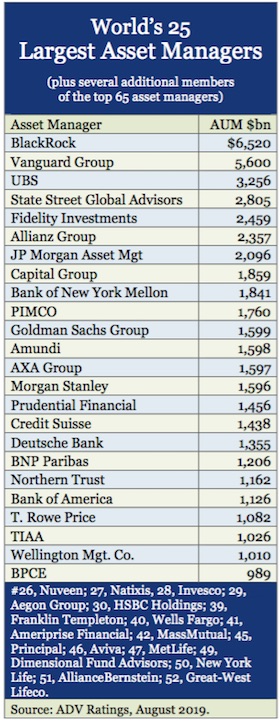

Financial advisors’ cell phones must have been ringing with anxious client calls last night. Yesterday’s 3% drop in the S&P 500 Index undoubtedly made a lot of people nervous. And, if the advisors followed their training, most of them probably told a lot of people to “Stay the course,” as Jack Bogle liked to say.
“We’re prepared for days like this,” the advisors will say. “Trying to time the market never works. If you sell now, how will you know when to get back in?”
Clients want to believe that their advisors are getting paid, in part, to warn them before an equity crash happens, and to tell them when to get out of stocks. But advisors do not necessarily believe this to be part of their job.
For advisors who sell annuities, market tremors are known to stimulate business. After a bit of volatility, older investors in particular show more interest in taking profits out of the market and parking them somewhere safe.
These older investors may never have heard about annuities before. But when they start looking for an asset that offers higher yields than bonds, that’s where their inquiries may lead them. Crises are excellent opportunities for advisors to educate clients about annuities.
Structured annuities, officially known as registered index-linked annuities (RILAs), should logically enjoy a burst of sales right now. People who still have more than half of their money in stocks are probably risk-tolerant enough to like the -10% floor or buffer and generous upside potential that these products offer. Such clients won’t need to step all the way down in risk to a fixed index annuity.
As for pension-less people who are about to retire, and who will need monthly income very soon, yesterday’s volatility might even nudge them into selling some of their highly appreciated stocks and buy an income stream. It could be a deferred income annuity, a single premium immediate annuity, or even a period-certain annuity.
In my opinion, the low interest rate environment shouldn’t necessarily be a barrier to buying an income annuity. Stocks are high in part because interest rates are low. Income annuities aren’t as expensive as they look if you believe that you’re buying them with inflated equity profits.
In the real world, I’ve never heard of an advisor using that rationale to sell income annuities. Before accepting that argument, equity investors would have to admit that luck, tax cuts, share buybacks and a Wall Street-friendly Fed are responsible for about half of their paper wealth. They’re not likely to do that.
In any case, the tea leaves don’t look ominous enough (yet) to justify panic. As of last week, Steve Slifer of NumberNomics believed that there’s not much to fear. Here’s what he said in his August 9 report:
“In our view the markets should stop worrying about a recession — something that is not going to happen. Thus, any pullback in the stock market should be viewed as a buying opportunity rather than the beginning of a downturn. The S&P 500 certainly feels like it has fallen precipitously in the past couple of weeks, but the reality is that it is only 4.0% below its recent record high level.”
“Furthermore, long-term interest rate levels should be viewed by corporate leaders (and perhaps the U.S. government) as an opportunity to raise needed cash at the lowest level in years. This is not adding up to a recession scenario in our book.”
© 2019 RIJ Publishing LLC. All rights reserved.

While Prudential Financial’s history dates to 1875, the Newark, NJ-based insurance and asset management firm has changed dramatically in recent years. After demutualizing in 2001, the firm acquired American Skandia’s variable annuity business, then CIGNA’s retirement plan business, then Hartford’s life insurance business, among other changes.
During the variable annuity arms race of the 2000s, Prudential regularly topped the variable annuity sales charts with its flashy Highest Daily income guarantee. The product came through the financial crisis relatively unscathed, thanks to a self-protective risk management method. Prudential has also been a prolific advertiser, notably for its longevity-awareness TV campaign with Harvard’s Dan Gilbert.
Within the last five years, Prudential has pivoted to new initiatives in global pension risk transfers, financial wellness programs for retirement plan participants, and a global wealth management business. It has launched new individual annuities, such as the PDI (Prudential Defined Income) variable annuity, the PruSecure and SurePath index annuities, and the GIFT (Guaranteed Income for Tomorrow) multi-premium deferred income annuity.
Kent Sluyter, an actuary and 28-year Prudential veteran who became president of Prudential Annuities in 2017, recently spoke with RIJ at length about annuities, financial wellness, and more. Here’s a condensed transcript of the conversation.

Sluyter.
RIJ: Financial wellness is a big topic among retirement plan providers today. Prudential has added financial wellness and financial education programs to its menu of services for retirement plan sponsors, and published white papers about the importance of financial wellness programs. What’s the business reason for developing and marketing these programs?
Sluyter: From a business perspective, there’s a near-term, medium-term, and long-term driver of financial wellness programs. At the near-term, they increase our ability to win and retain institutional clients in the retirement and group insurance space.
RIJ: I see. So it helps you compete against other plan providers.
Sluyter: Yes. In the intermediate-term, we believe that our engagement with those employees will increase their utilization of our retirement savings and other benefits. Participants increase their contributions to 401(k) plans when they’re more educated about the benefits of saving. And the participants often feel less stress and have higher productivity.
RIJ: So financial wellness helps you build assets under management. And what would be the long-term benefit?
Sluyter: The third benefit for us, in the long-term, is that we can provide those individuals with retail solutions, beyond the worksite benefits. We can drive a deeper relationship with them and offer them different solutions. Winning rollovers would be an element of that long-term strategy. Financial wellness is also an opportunity to sell life insurance, in a way that reaches more individuals than will ever talk to an advisor. It’s primarily an avenue for selling more life insurance, but I wouldn’t rule out the income side.
RIJ: What does financial wellness cost the plan sponsor? Plan sponsors are said to be hungry for data that these programs pay off for them.
Sluyter: Financial wellness programs are not an added cost.
RIJ: Now, within, or in addition to financial wellness, you have a financial education program called Prudential Pathways, right?
Sluyter: Today, we serve about five million individual customers through our advisory channels. Prudential’s existing financial wellness offerings, including the company’s digital financial wellness platform, has been deployed to more than seven million individuals across more than 3,000 organizations.
Prudential Pathways, our on-site financial education program, has been adopted by nearly 600 employers. It’s a natural pipeline for us to reach an added 20 million people that we wouldn’t have the capacity to reach through 3,000 advisors. It is also a powerful retention tool and source of qualified lead generation for Prudential Advisors, and because of the access to new retail customers that the program offers, we’ve also been able to attract a meaningful number of experienced financial advisors to Prudential.
RIJ: Are you watching the progress of the SECURE Act/RESA closely? If they become law, and it becomes safer, from a liability standpoint, for plan sponsors to embed almost any type of annuities into their plan, would that be a game changer for Prudential?
Sluyter: As you have seen, there’s also a potential for greater in-plan guaranteed income solutions. Some of the bills and proposals in Washington are creating awareness of that. But that will take a little bit longer.
RIJ: So, from the provider’s perspective, financial wellness can generate new and higher revenues. But do ‘grownup’ employees actually need assistance with their household finances?
Sluyter: There are individuals who are struggling. We’ve seen the data on debt. We’re helping people manage through that debt to a better situation. There’s also a sizable segment that is saving but not sure they are doing the right thing. Our data shows that almost half of people 55 and over give themselves a ‘C’ for financial literacy.
RIJ: But people are deluged with financial information all the time, aren’t they?
Sluyter: Despite today’s information overload, there’s a real gap with respect to the amount of knowledge people have about saving for retirement. A sizable population is trying to save. But there is not an equally sizable number who reach retirement having saved enough. We’re trying to help those who are struggling, or who are in ‘the middle of the pack,’ as well as those who have done a good job saving.
The solution might be as simple as managing day-to-day finances better. Or, if the opportunity is there to consider both options, it could mean helping people decide whether to stay in their plan or capture a rollover. It’s hard to say where things are headed.
RIJ: We reported recently that Prudential has introduced its first fixed indexed annuity, or its first one in many years. What are your plans for that product line?
Sluyter: We are relatively new to that space. We launched our first one last year, PruSecure, and we’ve gotten traction in the IBD (independent broker dealer) channel. That’s a commission-based product. We just launched an additional product this week in the IMO (insurance marketing organization) channel, SurePath, which has GLWB (guaranteed lifetime withdrawal benefits) capability.
We recognize that about half of FIA sales are in the IMO channel. FIAs represent only about 10% of our annuity sales now. But, given where the market seems to be going, we see fixed annuity sales growing more than variable sales.
On the variable side, business hasn’t changed much. Sixty to 70 percent is GLWB. The IMOs make greater use of the GLWB than the banks or the wirehouses. I would like to see that start to grow.
RIJ: Many annuities are looking toward the RIA channel and fee-based advisors in general for ‘blue ocean’ growth. Do you plan to create a no-commission FIA, perhaps to put on the DPL Financial Partners or RetireOne platforms, where RIAs without insurance licenses can buy FIAs?
Sluyter: We are not on either the DPL Financial or the RetireOne platforms. We’ve been focused on the Envestnet Insurance Exchange. We expect to see that develop. Nobody has begun doing business there yet.
RIJ: Do you see the RIA market as having potential for annuities? The data that I’ve seen from a Practical Perspectives report shows only a handful of RIAs saying they recommend annuities to their clients.
Sluyter: It’s hard to get a good number on the percentage of RIAs recommending annuities. It might be larger than the raw data might suggest. We think as many as 40% of RIAs are recommending life insurance or annuities to clients. The technology is a critical element for this to work. It’s absolutely where we need to be. Envestnet is closing that gap with its Insurance Exchange.
RIJ: What’s required to convert RIAs to annuities?
Sluyter: It’s more than a matter of ‘if we built it they will come.’ The insurance carriers need to speak the language of RIAs. We must engage with how they look at the world. We think of our obligation to RIAs in four quadrants: product solution, technology, engagement, and fee withdrawals.
We have a fee-based product on the market, and we are working on new product designs that will be launched later this year. They’re intended to be responsive to what RIAs are looking for. That includes the kind of transparency they want. It’s still a work in progress. There’s a simplicity aspect to that. We also have to provide them with the type of investments they’re familiar with, like low-cost institutional share classes. We have to make it easer for them to handle fee withdrawal management.
RIJ: What kind of income solution would you pitch to RIAs?
Sluyter: It could involve some longer-term solutions, like the CDA [contingent deferred annuity] longevity wrap products. We might potentially go back to that kind of stand-alone living benefit solution. There’s technology that makes that possible. We could see a resurgence in those ideas. It’s not a new idea, but its time may be coming closer.
RIJ: CDAs are essentially GLWBs, though, and the number of annuity owners opting for the GLWB rider has been declining for several years, right?
Sluyter: The GLWB has become less in favor. That’s occurring at a time when returns are strong. It’s natural for advisors to look more to accumulation, and not feel the need to lock in the gains with guaranteed products. In a more uncertain time, maybe that would be different. I think we’re seeing more advisors thinking about taking some of the money off the table.
So it remains to be seen what will happen with the GLWB. That might come back into favor. The industry sold the most variable annuities right after the market crashed. Given the run up in equity prices in the last 10 years, advisors should be looking at taking some of that off the table. That’s one of the drivers in the sale of FIAs. The RIA channel might not be the first place where that will show up.
RIJ: Speaking of variable annuities, a lot of insurers have had trouble managing their VA blocks of business since the Great Financial Crisis. Contract owner behavior with regard to using living benefits is hard to predict. Is that the case with Prudential? Your VA block is worth about $161 billion, as of June 30, 2019.
Sluyter: We are actually very happy with our in-force block of variable annuities. That’s not a universal sentiment in this industry. Our in-force block is performing well.
RIJ: As I understand it, Prudential’s individual variable annuities with living benefits were the only products of that type to use something like the Constant Proportion Portfolio Insurance (CPPI) risk management technique. It allowed Prudential to use an automatic, algorithm-driven asset allocation process by which policyholders’ portfolios are rebalanced into safer assets when the account value starts falling below the amount needed to cover the guarantee. As I understand it, that methodology has protected Prudential’s ability to meet its obligations when stocks drop.
Sluyter: We feel that we’ve taken the right steps to manage and hedge that risk. We continue to use the same techniques as in the past. We are using even more sophisticated techniques to drive down volatility. From a capital standpoint, we continue to manage that system the way you described, but we do not refer to the algorithm as a CPPI strategy, because it works a little bit differently from pure CPPI. We officially refer to the algorithm as the “predetermined mathematical formula.” The key driver of the predetermined mathematical formula in our product is the spread between the guarantee, or “Protected Withdrawal Value,” and the account value. Transfers could happen even if sub-accounts are growing, but not keeping pace with the guarantee.
RIJ: What’s your top VA product today?
Sluyter: A fairly significant part of our VA growth has come from our Prudential Defined Income (PDI), where the subaccounts only hold bonds. It responds to the “income now” market [as opposed to the deferred income or “income later” market served by GLWBs with deferral bonuses]. PDI has grown significantly in popularity and now accounts for about half of our VA sales.
RIJ: With respect to distribution, a certain portion of Prudential annuity sales still goes through your career agent force, right?
Sluyter: We do have a captive force. About 25% of our annuity sales come thorough our captive agents, the Prudential Advisors. They sell the same products that we sell though third parties. But as we get into the IMO [insurance marketing organization] space and develop products for the RIA channel, we’re headed for customization. We’ll customize either by distribution channel or on a client-by-client basis.
RIJ: Could you tell us something about Prudential’s “Guaranteed Income for Tomorrow,” or GIFT program. It’s a flexible premium deferred income annuity, right, delivered partly or mostly over the Internet?
Sluyter: Yes, GIFT involves contributing small amounts every month to build income at retirement. We’re still learning how to engage individuals, and how to present information around guaranteed income concepts. It sounds easy, but it’s difficult. We’ve gone through multiple iterations. GIFT was intended to be an all-digital consumer channel. But we’ve found that very few consumers are comfortable making an annuity purchase decision until they talk to an advisor. The industry is not at a point where people can just click and buy an annuity. That’s been a learning experience for us.
RIJ: So how will you deliver the service?
Sluyter: Right now we’re looking at the “omni-channel” model. We provide web-based education and, once people educate themselves, they can pivot to a live advisor. The advisor and client could have an online conversation or a live, face-to-face meeting. Or people could engage face-to-face and then go digital.
RIJ: Who’s the target audience for GIFT?
Sluyter: We offer GIFT through institutions and through associations. We have benefit plans with professional associations, and those associations can provide it as a service to their members. It’s directly available on prudential.com. Also, as advisors migrate up the wealth scale, they’re leaving a large segment of the population without advice. GIFT fits that underserved population. We are passionate about reaching the underserved.
RIJ: Thank you, Kent.
© 2019 RIJ Publishing LLC. All rights reserved.
Your nine-digit Zip code is a clue to how long you’ll live, and pension plan consultants can benefit from learning what it is.
Club Vita, a provider of longevity risk data, has published “Zooming in on ZIP Codes,” a white paper that addresses how integrating ZIP codes and other socioeconomic factors can help pension plan sponsors better capture the diversity of their participant bases, sharpen life expectancy estimates, and assess how much money to save to make their future payments.
Club Vita and Mercer, the global pension and benefits consultant, have developed a new longevity model for U.S. pension plan participants. The proprietary model, VitaCurves, employs the nine-digit ZIP code, or ”ZIP+4 code,” which offers significantly more detail on geographical differences in life expectancy than other methods.
According to Club Vita’s report, life expectancy increased at a faster rate for more financially well-off retirees between 2001 and 2014. Statistics from the VitaCurves model also identified specific characteristics of individuals within pension plans that resulted in increases and decreases of liabilities of up to 6% relative to the standard Society of Actuaries tables. With a reduction of liabilities on average, the paper says most plans could be over-valuing their liabilities.
Club Vita’s ZIP+4 code model will also facilitate the development of new products, allowing pension plans to prepare themselves for extreme longevity events, such as medical breakthroughs, while keeping control of plan assets. In addition, the reduction in uncertainty enables insurers of blocks of pensions to offer lower prices to take on this risk.
Club Vita extended its global footprint to the massive U.S. market in 2019. The company initially launched in the UK in 2008 and brought its model to Canada in 2015. In June, Mercer announced it was the first consulting firm to offer Club Vita’s longevity risk reporting to its clients in the United States.
The white paper, “Zooming in on ZIP Codes,” can be accessed here. Club Vita’s ZIP code model will be available for use on September 1, 2019 by Mercer clients and any pension plan that signs up directly with Club Vita.
© 2019 RIJ Publishing LLC. All rights reserved.
Retirement plan providers who offer financial wellness programs struggle to measure the return on investment for plan sponsors, and measurement of success and ROI are a frequent impediment to adoption and implementation of such programs, according to Cerulli Associates, the global research firm.
“While improved education on these topics offers employees a better understanding of how to budget and plan for life expenses, plan sponsors are challenged by the costs associated with the programs and proving the benefits,” Cerulli said in a release this week.
Financial wellness programs emphasize holistic advice beyond an individual’s workplace retirement savings account and address topics such as budgeting, debt management, and healthcare expenses.
Some plan sponsors are flexible and want to feel comfortable that the financial wellness program is helping employees at a reasonable price, the release said. Others, however, maintain strict budget policies that require achieving a specific return on investment to secure program funding.
Cerulli recommends that providers operate under the assumption that plan sponsors want hard facts rather than “a feeling of comfort.”
To measure the success of a financial wellness program, providers must identify specific goals for the program and a reasonable timeframe in which to achieve them. “Financial wellness programs should be grounded in metrics that impact a company’s bottom line,” Cerulli said.
Some goals, such as improving employees’ retirement readiness are straightforward to measure. Others, such as improving financial literacy, increasing workplace productivity, and decreasing employee stress, are harder to directly attribute to a financial wellness initiative.
To benchmark success, providers should consider leveraging recordkeepers’ digital platforms to track participant behavior (e.g., click rates, interactions per website visit) and engage with advisors/consultants to consolidate data from each of a plan sponsor’s financial wellness vendors.
These findings and more are from the August 2019 issue of The Cerulli Edge—U.S. Asset and Wealth Management Edition.
© 2019 RIJ Publishing LLC. All rights reserved.
Three years ago, a startling lawsuit was filed against the prestigious Massachusetts Institute of Technology (MIT), accusing it of including high-cost Fidelity mutual funds in its employee retirement plan in return for millions of dollars in donations from Fidelity-controlled charities.
That slow-moving lawsuit was back in the news this week. Attorneys for the MIT plan participants filed a memorandum opposing MIT’s motion to dismiss the case. The plaintiff’s counsel, Schlichter, Bogard & Denton of St. Louis, has sued many plan sponsors since 2006, often alleging failure to eliminate high-cost funds from their plans’ investment line-ups.
The plaintiffs claim that MIT and Fidelity cooperated in a quid pro quo as plan sponsor and full-service plan provider, respectively. The suit alleges that MIT’s retirement plan paid some $45 million in unnecessarily high fees for Fidelity investments and that Fidelity directed some $23 million in donations to MIT in return. Fidelity co-owner Abigail Johnson is a lifetime member of MIT’s board of trustees, the suit said.
Here’s a novel cure for high dependency ratios in an aging society: Pay couples to have children. In Greece, deputy labor—as in work, not in natal delivery—minister Domna Michaelidou has proposed paying 2,000 euros to parents of every newborn child in Greece starting January 1, 2020. She revised her statement from the beginning of the week that the labor benefit will be given to mothers below 30 years old.
“Everybody will receive 2,000 euros, as expenses for a child birth are dissuasive for the family,” she said. In a previous announcement, she promised an incentive of 1,000 euros per child for women under 30 and means-testing for the well-to-do.
Perhaps you have a 60-something client in the “green zone” (i.e., fully funded for retirement) who keeps going to work every day even though he or she can afford to stop. If groundless financial insecurity holds such clients back, the well-known advisor Jonathan Guyton has a solution. He calls it the “as-if retirement.”
In the August issue of the Journal of Financial Planning, Guyton suggests re-arranging a client’s finances on paper (not with actual trades) to preview his cash flows in retirement. In his example, a 64-year-old client wants to claim Social Security at age 70 but feels nervous about giving up his paycheck.
The solution: Show the client his cash flow “as if” he retired today. Guyton divided the client’s assets into a “bridge” account (enough to fund living expenses until the Social Security claiming date); a “core” account (the two-thirds of his savings that will generate income each year from age 70); and a discretionary account for the rest of his money.
The next step is to “turn on” distributions from the bridge and core income, as if the client were retired. Those distributions, plus his income from working, flow into his discretionary account. He gets a report every quarter, modeling the flow of funds as they will occur in retirement. “By seeing the mechanics of his retirement income in operation, an aspect of any ‘not enough money’ fear is eliminated,” Guyton wrote.
OregonSaves, the state-sponsored Roth IRA program which allows workers without employer-sponsored retirement plans to save through payroll deferrals, has welcomed cannabis (marijuana) businesses and their employees to join the program since last February.
It’s a “move toward inclusivity for an industry that has typically been excluded from other program,” according to an OregonSaves release this week.
Two years after its launch, OregonSaves, the statewide retirement program, has reached $25 million in retirement savings by over 100,000 participants. Five states and two cities are following Oregon’s lead in creating savings opportunities for the roughly half of American workers with no employer-sponsored plan.
OregonSaves began with a pilot in July 2017 and is expanding statewide in waves, having started with the largest employers. The rollout is currently for those with 10 or more employees and will conclude in 2020.
More than 7 in 10 workers auto-enrolled into the plan have elected to stay in it; workers are savings an average of $11 per month, and millions of dollars has been saved by workers who were not saving before, the release said.
“I’m 30 and now just thinking about my future,” said John Malott, Data Entry professional for McMinnville-based nonprofit Provoking Hope. “For the first time in my life, I’m thinking ahead. Where I’m at today is a 180 turn—I never even had a bank account before. I’m grateful these types of programs are available to get people on the right track.”
Since last year, OregonSaves has been open to the self-employed and to itinerant “gig” workers as well as full-time employees. Hundreds of individuals have self-enrolled.
The comic/dramatic/action actor Nicholas Cage in his own words, from an interview in the August 6, 2019 edition of the New York Times:
“You have good investments and bad investments. The good investments came from personal interest and my honest enjoyment of the history. For example, Action Comics No. 1: I bought that for $150,000. Then it was stolen. I got it back and sold it for $2 million. But that was a good thing to have, because I had an interest that was sincere. The funny thing is, my real estate buying spree was what the real problem was. It wasn’t these other things like shrunken heads that the media liked to talk about.”*
[*Action Comics No. 1 features the first appearance of Superman. Cage has a son named Kal-El, which is Superman’s birth name. At one point, Cage owned properties in Malibu, New Orleans, the Caribbean and other locales, as well as one castle each in Germany and England.]
©2019 RIJ Publishing LLC. All rights reserved.

Impatient with their limited roles as relief pitchers, designated hitters or pinch runners on a financial advisor’s line-up card, annuities aim to be recognized as starters—dependable athletes who play airtight defense and, most importantly, deliver clutch hits in extra-inning games.
Warming the bench and languishing in the minor leagues is getting old.
In other words, annuity issuers want—and need—their products to be included as a matter of course in the model portfolios or asset allocation software tools that increasing numbers of advisors are expected to rely on in the future.
Right now, annuity manufacturers feel a breeze at their backs. The recent emergence of platforms like Envestnet Insurance Exchange (as well as DPL Financial, RetireOne, Orion or SIMON) and the availability of financial planning software that specifically includes annuities (like RetireUp or Cetera’s new SetIncome tool), has led annuity issuers to think they’re making headway in the advisor mind-space.
Are advisors, or the builders of model portfolios (like asset managers and turnkey asset management programs) and planning software getting more annuity-friendly? The answer depends on whom you ask.
Different perspectives
Sales executives in the annuity industry—professional optimists—believe that the years they’ve spent promoting annuities to advisors, including registered investment advisors or RIAs, have not been in vain. RIJ asked Joe Maringer, national sales vice president for Great American Insurance Group, which sells no-commission index annuities, if his company is working with RIAs or broker-dealers to embed fee-based products in their enterprise-wide model portfolios for advisors.
“We are, although we face the challenge of crossing regulatory bodies and the difficulty of opening a new insurance or fee-based FIA (fixed index annuity) policy, relative to an advisor’s ability to ‘move money with a mouse’ in investment accounts.
“If we’re left out, I wouldn’t suggest that it’s all on us as much as we’ve tried to talk about and make the ‘path to purchase’ easier for insurance in an advisory world. Things like SIMON, FIDx and other platforms are trying to help that.
Fact is, after days like yesterday in the market, there should be some advisors looking for principal protection and or lifetime income that a fee-based annuity can provide regardless of how they get access to it.
But if you talk to the broker-dealers, you hear a more skeptical version of the story:
“Our asset management area has about 15-20 different models that advisors can use. Most advisors still formulate and manage their own models, but a growing number are using these pre-prepared models. I’ve yet to see a single model include annuities,” said a source who asked not to be named.
“Most models are still about accumulation,” he added, “We do have some income-oriented models, but they are not really designed to provide retirement income. They will run Monte Carlo analysis and tell you the probability of not of running out of money if you make a 4% systematic withdrawal.”
The ‘holy grail’
The topic of model portfolios was the subject of a recent report from Cerulli Associates, the global research firm. Tom O’Shea, a managed accounts expert at Cerulli, told RIJ that life insurers who issue annuities aren’t a big presence in the model portfolio trend.
“On the one hand, there’s a real need for reliable income [in older clients’ portfolios], he said. “For an asset manager, total-return portfolios are difficult to [use as income generation tools] because of their volatility.
“But the insurers still resist creating products—or rather they haven’t been successful in creating products—that can be embedded in an advisory solution,” he said, adding that annuity wholesalers are still focused on touting the specific features of specific products when the model portfolio concept demands low-cost, easy-to-compare products.
O’Shea acknowledged that certain life insurers—he mentioned Jackson National and Allianz Life—are “a little more forward-thinking, but most annuity issuers still have a product approach. Anybody with a product-push mentality [is not going to succeed with RIAs].
“If insurers don’t embrace the model portfolio idea and continue to want to sell products with bells and whistles, they will be largely left out,” O’Shea said. “That’s not where clients are going. But there’s a need for income in the portfolio. So if you can construct an income product that operates in the advisor space, that’s the ‘holy grail.’”
One factor that appears to be in insurers’ favor: Cerulli research shows that 23% of advisors at insurer-owned broker-dealers are amenable to outsourcing their asset allocation chores to model portfolios—more than advisors at independent broker-dealers (18%). These are distribution channels, where sellers of variable and index annuities have had the most penetration. In the channels where annuities would like to get traction—wirehouses and RIAs—fewer than 10% of advisors favor using model portfolios.
Asset managers like BlackRock have been producing model portfolios for advisors for years, in a give-them-the-razor, sell-them-the-blades spirit. A few years ago, BlackRock added the iRetire platform for advisors of clients nearing or in retirement. The platform gives advisors access to all of BlackRock’s model portfolios plus the firm’s CoRI calculator.
The calculator estimates the cost of a dollar’s worth of retirement income, based on a client’s age and current bond prices. If you add in the value of the client’s nest egg, you get the amount of annual income that nest egg will produce in retirement. But no annuities are mentioned.
A spot in the software
The advisory audience that annuity issuers most wish to penetrate, of course, is the RIA, which represents a green field source of business precisely because penetration has been so low. Annuity issuers have long insisted that because RIAs are fiduciaries and are obligated to act in their clients’ best interest, they should always consider annuities when the client would clearly benefit from owning one.
Issuers have also promoted the idea that RIA clients with income annuities can take more risk—and potentially get higher earnings—with their non-annuitized wealth. But these ideas have arguably resonated more inside the annuity issuers’ own echo chambers than in the minds of RIAs.
While annuities may not currently exist in many, or any, model portfolios, they do appear in some of the software programs that independent broker-dealers (IBDs) and insurance marketing organizations (IMOs) make available to their advisors. There are modules in the programs where advisors can model the impact of adding annuities to portfolios. Programs like RetireUp, IFLM, inStream, MoneyGuidePro (available on the Envestnet Insurance Exchange) are some of the available software programs that can model the inclusion of annuities in retirement income plans. Jerry Golden of Golden Retirement uses his own proprietary software, which includes annuities.
Cetera, the wealth management platform, RIA and broker-dealer, has entered a partnership with Allianz Life and Capital Group to offer an income-planning tool to Cetera advisors. The tool, SetIncome, takes client inputs — name, age, total income goal, initial investment and risk tolerance — and generates a basic retirement income plan that combines index annuities and investments.
“We’ve established a bifurcated process, with a traditional investment management portfolio on the one hand and an indexed annuity with an income rider on the other,” said Barton Liro, investment director, portfolio solutions group at Cetera Financial Group. “Today there’s just one specific Allianz annuity, the CoreIncome7, but we’ll open up the shelf to other products in the future,” he said. The independent advisors who use SetIncome are dually licensed; as fee-based fiduciary investment advisor representatives (IARs) and securities licensed. They will earn a commission on the sale of the annuity and an asset-based fee on the investments in the managed account. Using the tool, they’ll be able to show how the annuity increases the success of the portfolio,” Liro told RIJ.
Valuing a SPIA or DIA
Even if RIAs believed in adding income annuities, such as single premium immediate and deferred income annuities (SPIAs and DIAs) to their client’s retirement portfolios, they would still be hindered by the difficulty they face in charging a wrap fee on the value of the annuity. If they don’t know how to value the annuity, they won’t know how much to charge for it—in which case they can’t charge for it and won’t recommend it in the first place.
“There are many fee-based advisors who are not comfortable charging on SPIA, and therefore won’t recommend one,” said Michelle Richter, managing director, RET Solutions, at Milliman, the global actuarial consulting firm. “But if you could calculate a value for an annuitized income stream—a book value that’s adjusted over time—that might make some RIAs feel comfortable about recommending a SPIA.”
Career agents at mutual insurers, not independent reps or RIAs, have traditionally sold most SPIAs and DIAs, but Richter thinks that there’s an untapped minority of RIAs who would use the “Safety First” approach to retirement income planning—which entails using guaranteed sources of income to cover essential expenses–if they could resolve the compensation dilemma.
© 2019 RIJ Publishing LLC. All rights reserved.
